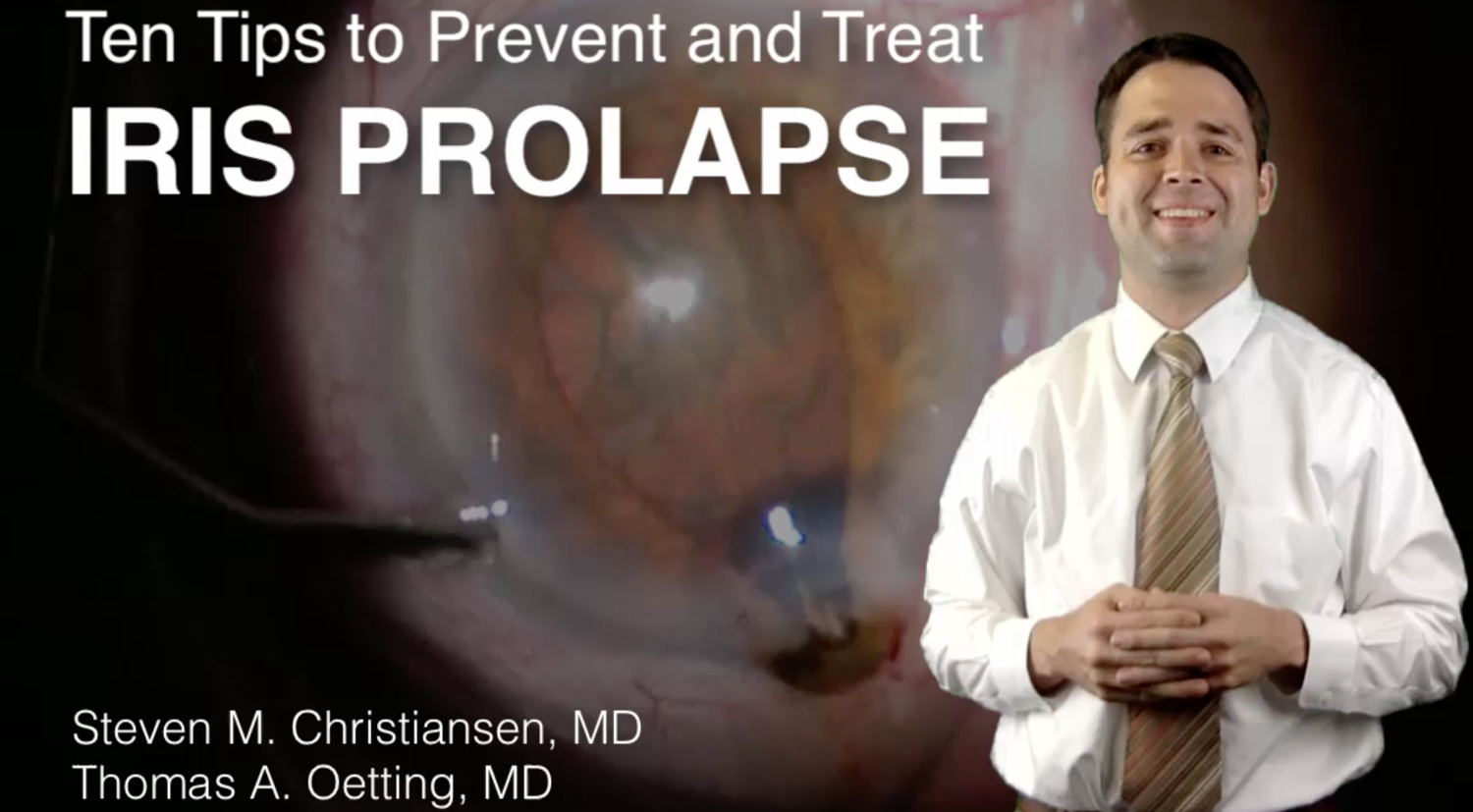In this post (and video!) I will share ten tips to prevent and treat iris prolapse, a challenge encountered fairly frequently during cataract surgery, particularly for beginning surgeons.
First we will begin with prevention.
1. Create a longer wound
One of the factors driving the pressure-driven movement of the iris to the wound is the distance from the iris to the internal opening of the wound. If you are concerned about the potential for iris prolapse, consider making a slightly longer clear corneal wound.
2. Avoid overfilling the anterior chamber with viscoelastic
Beginning cataract surgeons often overfill with viscoelastic as it is easier to make the main wound in a firm eye, however this creates a larger pressure differential between the anterior and posterior chambers, and increases the risk of iris prolapse, particularly during hydrodissection. A rule of thumb that I try to use, is that if I am getting a lot of viscoelastic spilling out of the paracentesis, I have overfilled the AC and should be weary of possible prolapse.
3. Remove excessive viscoelastic before hydrodissection
The video above shows a resident surgeon treating iris prolapse by removing viscoelastic from the anterior chamber, but the same principle applies to preventing iris prolapse. Hydrodissection poses the greatest risk of prolapse, and taking measures to prophylactically lower the anterior chamber pressure by removing viscoelastic is critical in preventing prolapse.
4. Create a fluid tract before hydrodissection
Also in the video, you can see the surgeon injecting BSS and manually creating a path for BSS to exit the eye. This helps avoid the situation where the BSS cannot leave the eye without taking with it viscoelastic, which could result in a rapid decrease in anterior chamber pressure, a main risk factor for prolapse.
5. Support the iris mechanically with iris hooks or a ring stabilizer
This can be done by either placing a single iris hook posterior to the main wound, or by placing the hooks in a diamond configuration with one of the hooks posteriorly in a similar fashion. Alternatively, a Malyugin ring stabilizer can be used as seen here. Mechanically supporting the iris is particularly helpful if you are concerned about possible intraoperative floppy iris syndrome.
Now let’s talk about intraoperative treatment of iris prolapse.
6. Stop! Resist the urge to reposit prolapsed iris
As soon as iris prolapse occurs, the knee-jerk reaction is to want to immediately push the iris back into the eye. It can be tough to overcome this urge, but realize that it is usually in stuffing the iris back in that pigment is permanently lost from the posterior iris. Also, rarely is this actually effective. Instead, you should immediately go to the paracentesis and release trapped fluid or viscoelastic to decompress the AC. In this case, you can see that burping viscoelastic helps create a potential space to reposit the iris, but this is not enough, and only by removing excess viscoelastic using a cannula followed by additional burping from the main wound, is the iris able to be reposited easily.
7. Decompress the anterior chamber and then reposit the iris
Here we show a case of iris and lens prolapse during hydodissection. The surgeon does a nice job to resist the urge to reposit the iris, and recognizes the fluid trapped behind the lens, going in with a Drysdale to gently rock the lens, releasing the trapped fluid. The iris can then be reposited. Here you can see a case of prolapse during irrigation aspiration. The first move is to decompress the anterior chamber from the paracentesis.
8. Gently stroke the main wound
Tip #8 is to gently stroke the main wound with a cannula, which helps the iris be released back into the eye.
9. Lower the IOP/bottle height and descrease the aspiration flow rate
Once you have successfully reposited the iris, you should be thinking about how to keep iris from prolapsing again during the remainder of the case. One option is to lower the intraocular pressure or bottle height to decrease the aspiration flow rate, which helps avoid large fluctuations in anterior chamber pressure and decreases the risk of repeat prolapse.
10. Don’t make a bad situation worse
The final tip is to avoid making a bad situation worse. After prolapse, the iris architecture has been disrupted, and even a seemingly simple step like inserting the IOL could catch the peripheral iris and cause an iridodialysis. Notice here the subtle pause after inflating the capsular bag to place viscoelastic right below the main wound to create more space for IOL insertion.
Conclusion
Managing iris prolapse seems simple, yet it can be challenging to deal with, as you’ve seen from these excerpts of my own surgical videos, as well as segments of videos published by Dr. Tom Oetting at the University of Iowa. I hope you have found these tips to be helpful! Let me know what other tips you have in the comments section below or on Facebook or YouTube so we can all improve our ability to manage iris prolapse!
For more videos and detailed instruction on iris prolapse, visit eyerounds.org, affiliated with The University of Iowa Department of Ophthalmology and Visual Science’s and where this video was first posted. And for truly the best narrated videos on managing iris prolapse, be sure to visit Dr. Thomas Oetting’s “Cataract Surgery” Facebook page!
Finally, many thanks to Laser Locators, sponsor of the Millennial Eye Live 2017 Surgical Video Competition, who awarded this video 3rd Place!








